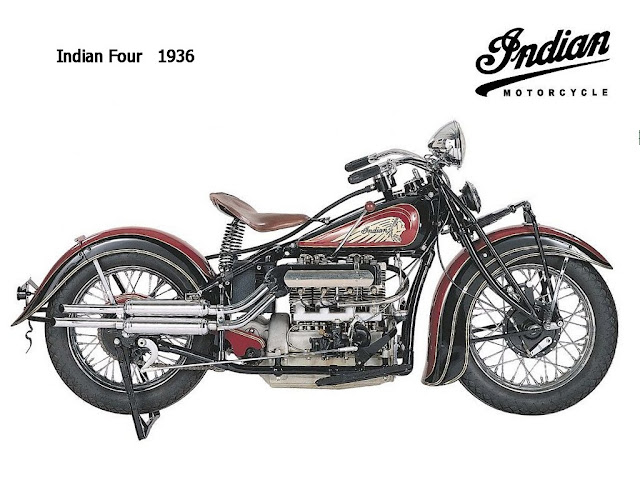Indian Four
This 1939 model Four was one of the last before the model was redesigned with the large ‘skirted’fenders that would become an Indian trademark. The 1939 bike benefited from numerous updates made over the years, and incorporated features including right- hand gearchange (the lever is visible alongside the Indian’s headdress logo on the gas tank), and fringed leather saddle.
Indian’s Four was stylish, comfortable, fast and expensive. Rather too expensive ever to sell in large numbers, in fact, although it remained in production for more than 15 years. During that time the Springfield, Massachusetts-based giant made numerous updates to the Four, which it acquired in 1927 by purchasing the rights and tooling of the Philadelphia-based Ace firm, which had gone into liquidation three years earlier.
The Ace had been designed by William Henderson, co-founder of the Henderson marque, and had been updated following his death in a crash while testing one of his bikes in 1922. Ace had a fine reputation for speed and quality, and Indian’s initial response after taking control was to restart production of the Four with virtually no changes. Under Indian production the bike was initially still called simply the Ace, although from June 1927 it was rebadged the Indian Ace, and offered in Indian’s traditional dark red colour as well as the original blue.
By the standards of the day the Indian Ace was one fast and glamorous machine, with a smoothrunning 1265cc, inlet-over-exhaust engine producing 35bhp, a top speed of 80mph (129km/h) and good handling too. In June 1927, Motorcycling magazine enthused that, ‘just for fun we slipped the gears into second, slowed down to about 20mph [32km/h] and then opened the throttle wide. A twist of the wrist and we were nearly blown off the saddle... The new Indian Ace packs a wallop in all four barrels.’
In 1928. Indian decided that the Ace label was no longer needed, and introduced an updated Four that was badged simply as an Indian. Around this time the factory had a short-lived policy of introducing improvements as soon as they were ready, rather than waiting for specific model years. Over the next few years Indian modified the four with a stronger crankshaft (with five main bearings instead of the previous three), twin-downtube frame, leaf-spring front fork and a more efficient twin-shoe front brake.
Weight gain
For the 1932 season the Four was restyled with a more streamlined tank, longer front forks and a stronger frame, gaining weight to a substantial 4951b (225kg) in the process. As before it came as standard with a left-hand throttle and right-hand shift for the three-speed gearbox, but from '32 could be ordered with the controls reversed for no extra cost. By this time Indian sales had slumped to a record low in the Depression, following the rest of the American auto industry.
In 1933 Indian built a lowest ever total of just 1667 bikes, of which only about 130 were the expensive Four. Many of those went to police forces, which rated the model highly. Three years later the economy had begun to recover, but Indian took a wrong turn with the Model 436 Four, which had its valve arrangement reversed in an ‘exhaust over inlet’ layout. Indian billed the bike as ‘the world’s finest, world’s fastest stock motorcycle’. But its more cluttered engine look was unpopular, and the model gained the nickname ‘upside-down Four’ before the old-style valve layout was reinstated shortly afterwards.
The last Fours, built between 1940 and 1942, were redesigned with huge skirted fenders and rear suspension. They were stylish and comfortable, if heavy and slow-steering. Then came the Second World War, during which Indian produced large numbers of military V-twins, and developed prototype four-cylinder machines called the X44 and the Torque Four. But these came to nothing, and production of Indian’s four-cylinder flagship did not restart after the war.
By 1931 the Four had undergone improvements under Indian’s policy of continual development, but still had the old-style fuel tank with a frame tube running above. Although less sophisticated than most later variants, the 1931 Four was also lighter. But sales in the early 1930s were very poor.
Although its look is very similar, this is not an old Indian but a new four- cylinder machine called the Dakota 4, built in 2000. The Dakota 4 was designed in Sweden and produced in small numbers in Scotland by Alan Forbes, an Indian enthusiast and spares dealer who owned the Indian name in Britain and some other countries.
Specification Indian Four (1939)
- Engine Air-cooled eight-valve inlet-over-exhaust in-line four
- Capacity 1265cc (69.8 x 82.5mm)
- Maximum power 40bhp @ 5000rpm
- Transmission Three-speed, chain final drive
- Frame Steel twin cradle
- Suspension Leaf spring front; none rea
- Brakes Drum front and rear
- Weight 532lb (241kg)
- Top speed 90mph (145km/h)


















0 comments: